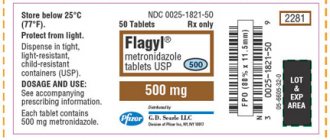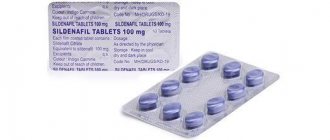Protionamide Akri
Release form, composition and packaging
Light orange to dark orange coated tablets, round, biconvex; Roughness is allowed.
- 1 tab. prothionamide 250 mg
Excipients: microcrystalline cellulose, potato starch, povidone, hypromellose, colloidal silicon dioxide, magnesium stearate, sodium carboxymethyl starch, talc, macrogol, hydroxypropyl methylcellulose, titanium dioxide, yellow-orange dye (orange S).
Clinical and pharmacological group: Anti-tuberculosis drug
pharmachologic effect
A second-line antituberculosis agent, it acts bacteriostatically and blocks the synthesis of mycolic acids, which are the most important structural component of the cell wall of Mycobacterium tuberculosis.
It has nicotinic acid antagonist properties. In high concentrations, it disrupts the protein synthesis of microbial cells and has a bactericidal effect. Effective against mycobacterium tuberculosis resistant to first-line drugs.
Use in combination with other anti-tuberculosis drugs reduces the likelihood of developing tuberculosis resistance.
Pharmacokinetics
Prothionamide is rapidly absorbed into the gastrointestinal tract, creating Cmax of the drug in the blood plasma 2-3 hours after oral administration. Penetrates into healthy and pathologically altered tissues (tuberculous foci and cavities in the lungs, serous and purulent pleural effusion, cerebrospinal fluid during meningitis). In the body it is partially converted into sulfoxide, which has tuberculostatic activity. Partially excreted unchanged (up to 15-20% of the dose taken) in urine and feces.
Indications
- treatment of all forms of tuberculosis, incl. if the pathogen is resistant to other anti-tuberculosis drugs (first line) or intolerant to them.
Dosage regimen
Take the drug orally after meals.
Adults are prescribed 0.25 g 3 times a day; if well tolerated - 0.5 g 2 times a day.
In patients over 60 years of age and with a body weight of less than 50 kg, the daily dose should not exceed 0.75 g (usually 0.25 g is prescribed 2 times a day).
Children are prescribed at a rate of 10-20 mg/kg body weight per day.
Side effect
Side effects of prothionamide occur in the gastrointestinal tract, liver, skin, endocrine and nervous systems.
From the gastrointestinal tract: loss of appetite, nausea, vomiting, dryness and metallic taste in the mouth. After discontinuation of the drug, these phenomena usually disappear quickly.
Often during treatment there is an increase in the level of transaminases in the blood. Severe liver dysfunction with signs of hepatitis and jaundice is rarely observed.
The hepatotoxicity of the drug depends on existing liver dysfunction, such as liver damage as a result of alcoholism or after surgery. These side effects are observed especially with combination therapy with isoniazid, rifampicin and pyrazinamide.
Skin reactions are rare; in some cases, pellagra-like reactions are described, respectively, with a combination of skin manifestations and disorders of the central nervous system.
Sometimes there are disturbances from the endocrine system. Along with the development of hypoglycemia (decrease in blood sugar less than 50 mg%) in patients with diabetes, the development of gynecomastia (enlargement of the mammary glands in men) has been described. Rarely, menstrual irregularities and impotence, as well as hypothyroidism (decreased thyroid function), are observed.
Prothionamide can sometimes cause peripheral and central nervous system disorders. Cases of polyneuropathy have been described in combination with isoniazid. Taking prothionamide can cause dizziness, headaches, impaired concentration, mental disorders (rarely - optic neuritis, tachycardia). Concomitant use of other anti-tuberculosis drugs that act on the central nervous system, such as isoniazid or cycloserine, may lead to increased central nervous system side effects. Taking alcohol at the same time can have the same effect. In some cases, allergic reactions and bone marrow disorders have been described.
Contraindications
Prothionamide should not be used for:
- individual hypersensitivity to the components of the drug;
- during pregnancy and lactation;
- acute gastritis;
- peptic ulcer of the stomach and duodenum;
- erosive and ulcerative colitis;
- acute hepatitis;
- liver cirrhosis;
- chronic alcoholism.
Pregnancy and lactation
The drug is contraindicated during pregnancy and lactation.
Use for liver dysfunction
The drug is contraindicated in liver cirrhosis and acute hepatitis.
special instructions
The combined use of prothionamide and alcohol should be avoided due to the risk of developing states of central nervous system excitation (associated with increased toxic effects of alcohol).
When using prothionamide in combination with isoniazid and cycloserine, special attention should be paid to the possibility of mental disorders.
Since the drug is constantly used in combination with other anti-tuberculosis drugs, regular monitoring of serum transaminases, gamma-glutamate transferase and alkaline phosphatase is necessary. Patients with diabetes need to monitor their blood sugar levels at least once a month.
Skin and especially mucous reactions may be the first signs of pellagra-like side effects. This should be regarded as a reason for the necessary discontinuation of the drug.
Drug interactions
When combining therapy for tuberculosis, the additive hepatotoxic effect of individual drugs should be taken into account. This particularly applies to the combination of prothionamide with isoniazid, rifampicin and pyrazinamide. An additive effect on the central nervous system is observed with the combined use of isoniazid and cycloserine.
Simultaneous intake of alcohol leads to an increased stimulating effect on the central nervous system. In certain cases, when taking prothionamide, it is necessary to reduce the dose of insulin or oral antidiabetic drugs used by mouth.
Due to metabolic competition, the transformation of other drugs in the body, for example, isoniazid or barbiturates, slows down.
Storage conditions and periods
The drug should be stored in a dry, cool place, protected from light, out of reach of children.
Shelf life: 2 years.
Do not use after the expiration date indicated on the package.


